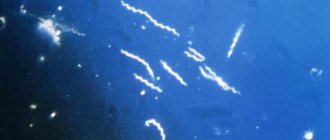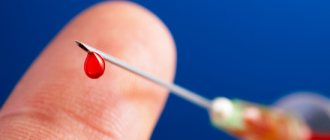Hepatitis C is asymptomatic in the vast majority of cases. For a long time, only mild malaise and increased fatigue may indicate the presence of infection. If the presence of a virus in the body is suspected, a diagnostic complex is prescribed, including general examinations and a blood test for hepatitis C. A similar diagnosis is carried out before prescribing antiviral therapy.
Enzyme-linked immunosorbent assay (ELISA)
One of the methods for diagnosing the hepatitis C virus is an ELISA test for anti HCV IgM and IgG. Its task is to identify antibodies, their set and quantity. The advantages of this type of diagnosis include high specificity, speed of obtaining results (no more than 3 days), low risks of obtaining false data.
Anti HCV IgG
Antibodies of this type are detected in the blood of patients who have been infected for at least 11-12 weeks. This immunoglobulin is present in the blood of patients during the recovery period, after acute hepatitis C and during remission of chronic HCV.
Anti HCV IgM
Immunoglobulins of this group are produced in active phases: during exacerbation of chronic hepatitis C and during the acute course of the disease. They can be detected in the blood 5-6 weeks after infection.
It is recommended to carry out ELISA tests against HCV IgM and IgG at the stage of pregnancy planning, to clarify the stage of the disease, as well as in case of symptoms indicating possible liver damage. It is important to remember that positive ELISA results only indicate the presence of antibodies, and not the presence of the virus itself. In 15-25% of cases, the presence of HCV IgM and IgG in the blood is confirmation that the body has coped with the disease on its own.
Complexes with this research
Hospital complex Infectious screening for prevention and hospitalization 2,140 ₽ Composition
Entry into IVF Examination when a woman enters the IVF procedure 23,500 ₽ Composition
Male check-up No. 1 39 studies for annual preventive examination 18,920 ₽ Composition
IN OTHER COMPLEXES
- Pregnancy planning. Diagnosis of infections 8,800 ₽
- Preparation for IVF for a man RUB 6,210
- Examination during pregnancy. 3rd trimester 9,840 RUR
- Future dad 8,650 RUR
- Examination during pregnancy. 1st trimester 17,040 RUR
Polymerase chain reaction (PCR)
The next step after anti-HCV IgM and IgG is a polymerase chain reaction test. With its help, it is possible to detect the RNA of the virus in human blood, determine the degree of load and the genotype of the disease. There are several types of PCR tests for hepatitis C.
- Qualitative testing is used to identify the genetic material of the virus in a patient's blood. The test result for hepatitis C is indicated as “detected” or “not detected”. In the second case, the indicator may be false negative. This occurs in cases where too little time has passed since infection and the number of pathogens has not reached the level determined during testing.
- Quantitative analysis allows you to determine the concentration of the virus. This indicator plays a key role in developing a treatment regimen for HCV. The decoding of the hepatitis C PCR analysis is issued in a digital value: less than <1.5x10*3 IU/ml - the concentration has not reached the lower threshold; <4x10*6 IU/ml – a small amount indicating the onset of the disease; >4x10*6 IU/ml – high amount; >2x10*8 IU/ml – concentration above the linear limit.
In addition to qualitative and quantitative analysis for hepatitis C, genotyping of the disease is carried out. Knowing the genotype, it is possible to accurately predict the response of the virus to treatment with a particular drug and develop an optimal treatment regimen.
Anti-HCV, antibodies, ELISA
Anti-HCV are specific immunoglobulins of the IgM and IgG classes to the proteins of the hepatitis C virus, indicating possible infection or a previous infection.
Synonyms Russian
Total antibodies to hepatitis C virus, antiHCV.
English synonyms
Antibodies to Hepatitis C Virus, IgM, IgG; HCVAb, Total.
Research method
Chemiluminescent immunoassay.
What biomaterial can be used for research?
Venous blood.
How to properly prepare for research?
Do not smoke for 30 minutes before donating blood.
General information about the study
Hepatitis C virus (HCV) is an RNA virus from the Flaviviridae family that infects liver cells and causes hepatitis. It is able to multiply in blood cells (neutrophils, monocytes and macrophages, B-lymphocytes) and is associated with the development of cryoglobulinemia, Sjogren's disease and B-cell lymphoproliferative diseases. Among all the causative agents of viral hepatitis, HCV has the greatest number of variations, and due to its high mutational activity, it is able to evade the protective mechanisms of the human immune system. There are 6 genotypes and many subtypes of the virus, which have different implications for the prognosis of the disease and the effectiveness of antiviral therapy.
The main route of transmission of infection is through blood (during transfusion of blood and plasma elements, transplantation of donor organs, through non-sterile syringes, needles, instruments for tattooing, piercing). Transmission of the virus through sexual contact and from mother to child during childbirth is possible, but this occurs less frequently.
Acute viral hepatitis is usually asymptomatic and remains undetected in most cases. In only 15% of those infected, the disease is acute, with nausea, body aches, lack of appetite and weight loss, and is rarely accompanied by jaundice. 60-85% of those infected develop a chronic infection, which is 15 times higher than the frequency of chronicity with hepatitis B. Chronic viral hepatitis C is characterized by “undulation” with an increase in liver enzymes and mild symptoms. In 20-30% of patients, the disease leads to cirrhosis of the liver, increasing the risk of developing liver failure and hepatocellular carcinoma.
Specific immunoglobulins are produced for the core (nucleocapsid protein core), shell (nucleoproteins E1-E2) and fragments of the virus genome (NS non-structural proteins). In most patients with HCV, the first antibodies appear 1-3 months after infection, but sometimes they can be absent from the blood for more than a year. In 5% of cases, antibodies to the virus are never detected. In this case, HCV will be indicated by the detection of total antibodies to virus antigens.
During the acute period of the disease, antibodies of the IgM and IgG classes are formed to the nucleocapsid protein core. During the latent course of the infection and during its reactivation, IgG antibodies to the non-structural proteins NS and the nucleocapsid core protein are present in the blood.
After an infection, specific immunoglobulins circulate in the blood for 8-10 years with a gradual decrease in concentration or remain for life in very low titers. They do not protect against viral infection and do not reduce the risk of re-infection and development of the disease.
What is the research used for?
- For the diagnosis of viral hepatitis C.
- For differential diagnosis of hepatitis.
- To identify previously transmitted viral hepatitis C.
When is the study scheduled?
- For symptoms of viral hepatitis and increased levels of liver transaminases.
- If you know about hepatitis of unspecified etiology.
- When examining people at risk for infection with viral hepatitis C.
- During screening examinations.
What do the results mean?
Reference values
Result: negative.
S/CO ratio (signal/cutoff): 0 - 1.
Reasons for the positive result:
- acute or chronic viral hepatitis C;
- previously suffered viral hepatitis C.
Reasons for negative results:
- absence of hepatitis C virus in the body;
- early period after infection;
- absence of antibodies in viral hepatitis C (seronegative variant, about 5% of cases).
What can influence the result?
- If the material is taken and stored incorrectly, an unreliable result may be obtained.
- Rheumatoid factor in the blood contributes to a false positive result.
Important Notes
- If the result is positive, to confirm the diagnosis of hepatitis C virus, a test is performed to determine the structural and non-structural proteins of the virus (NS, Core).
- If there are existing risk factors for infection and suspicion of viral hepatitis C, it is recommended to determine the RNA of the virus in the blood by PCR, even in the absence of specific antibodies.
Also recommended
- Anti-HCV, antibodies
- Antibodies to structural and non-structural proteins of the hepatitis C virus
- HCV, RNA [real-time PCR]
- HCV, RNA quantitative [real-time PCR]
- HCV, genotyping, RNA [real-time PCR]
- anti-HAV, IgM
- HBsAg
- anti-HBc, IgM
- Gamma-glutamyl transpeptidase (gamma-GT)
- Alanine aminotransferase (ALT)
- Aspartate aminotransferase (AST)
- Total alkaline phosphatase
- Serum albumin
- Total bilirubin
- Total cholesterol
- Thrombin time
- Fibrinogen
- Complete blood count (without leukocyte formula and ESR)
- Leukocyte formula
- Erythrocyte sedimentation rate (ESR)
Who orders the study?
Infectious disease specialist, hepatologist, gastroenterologist, therapist.
Literature
- Vozianova Zh. I. Infectious and parasitic diseases: In 3 volumes - K.: Health, 2000. - T.1.: 600-690.
- Kishkun A. A. Immunological and serological studies in clinical practice. – M.: MIA LLC, 2006. – 471-476 p.
- Harrison's Principles of Internal Medicine. 16th ed. NY: McGraw-Hill; 2005: 1822-1855.
- Lerat H, Rumin S, Habersetzer F, and others. In vivo tropism of hepatitis C virus genomic sequences in hematopoietic cells: influence of viral load, viral genotype, and cell phenotype. Blood. 1998 May 15;91(10):3841-9.PMID:9573022.
- Revie D, Salahuddin SZ. Human cell types important for hepatitis C virus replication in vivo and in vitro: old assertions and current evidence. Virol J 2011 Jul 11;8:346. doi:10.1186/1743-422X-8-346. PMID:21745397.
Biochemical blood test for hepatitis C
This type of diagnostics is among the most informative specialists. Based on the results of the analysis for hepatitis C, it is possible to determine the degree of organ damage and assess the general condition of the patient. The most important indicators in this laboratory test are bilirubin, AST and ALT.
Bilirubin
Normally, the amount of bilirubin in the blood should not exceed 19.8 µmol/l. An increase in pigment concentration indicates an activation of the process of erythrocyte breakdown and the presence of liver pathologies in the patient. Jaundice syndrome occurs when bilirubin levels increase above 30 µmol/l. The result of an analysis for hepatitis C with indicators from 30 to 86 µmol/l is confirmation of mild, 87-160 µmol/l - moderate, over 160 µmol/l - severe form of hyperbilirubinemia.
ALT and AST
They are enzymes produced by the liver. With HCV, their level rapidly increases and the enzymes reach the affected organ. The normal levels of AST and ALT are different for men and women. The AST level in women should be no more than 30 IU/l; in men, the test result for hepatitis C normally reaches 45 IU/l. For AST indicators, the norm is set within 30 and 47 IU/l, respectively.
Protein
The concentration of protein in the blood is affected by the process of synthesis and breakdown of two main fractions. The norm is the protein content in the blood in the range of 66-83 g/l. If, when reading tests for hepatitis C, a decrease in the indicator is detected, the presence of hepatitis or cirrhosis can be suspected.
Additional Research
Additionally, the de Ritis coefficient can be calculated, which is the ratio between ASI and ALT. In addition, changes in creatinine content, as well as an increase in triglyceride content, may indicate the development of pathologies. At the same time, do not forget that exceeding the norm of fat may indicate diabetes mellitus or obesity. The result of a test for hepatitis C based on a creatinine content of 39.9-72 µmol/l is normal. For triglycerides, the indicator is set at 3.62 µmol/l.
Preparation and delivery of blood tests for hepatitis C
The composition of the blood depends on many factors: the person’s condition; time of day; meals, etc. That is why preparation is necessary to obtain a reliable interpretation of a blood test for hepatitis C. Before donating blood, it is recommended:
- 2-3 days in advance, eliminate the consumption of alcohol, as well as fatty and fried foods;
- It is recommended to avoid stress and excessive physical activity during the day;
- You should refrain from eating any food for 8 hours before being tested for hepatitis C.
Experts also recommend stopping taking any medications. If this is not possible, your doctor should be notified.
Patients whose tests for hepatitis C have confirmed the presence of the disease should not despair. Modern medicine has means to combat the virus - drugs based on sofosbuvir, daclatasvir, velpatasvir and ledipasvir. The medicines have passed all the necessary stages of research and confirmed the effectiveness of antiviral therapy.
Patient preparation rules
venous blood
Standard preparation conditions (unless otherwise determined by the doctor):
4 hours before, withstand fasting, exclude fatty foods.
You can drink water. capillary blood Standard preparation conditions (unless otherwise determined by the doctor):
4 hours before, withstand fasting, exclude fatty foods. You can drink water.
You can add this study to your cart on this page


